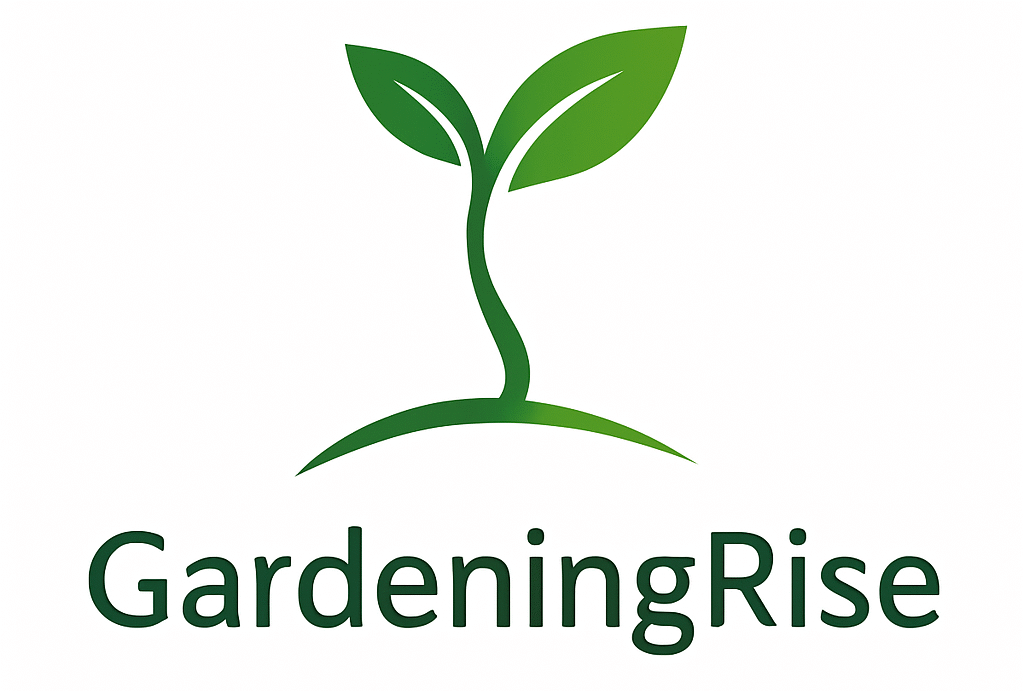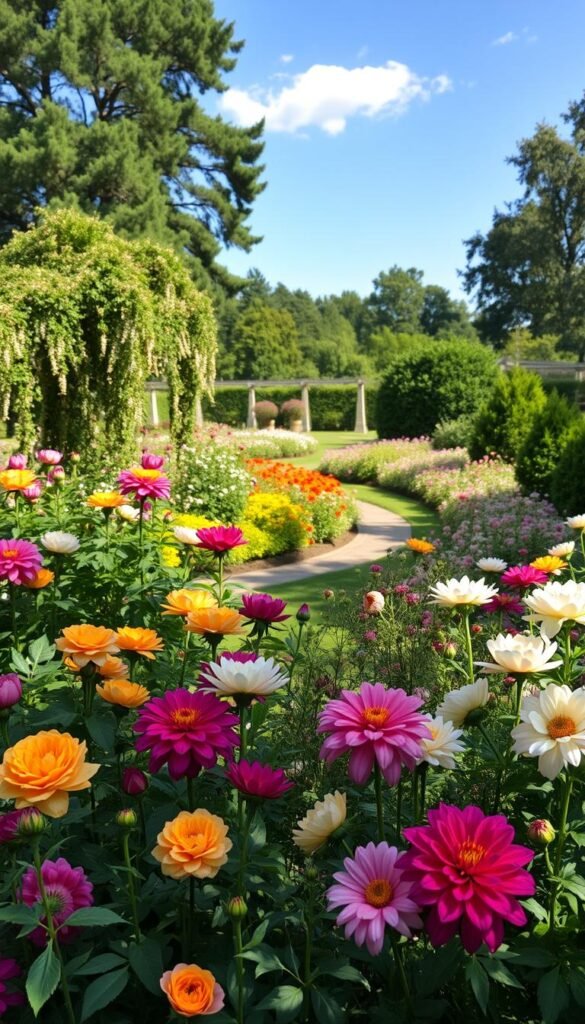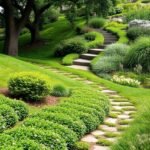Imagine stepping outside to vibrant colors and fragrant blossoms every month of the year. With thoughtful plant choices and smart layout strategies, your outdoor space can become a living masterpiece that thrives through spring showers, summer heat, and winter frosts.
A well-curated mix of perennials, annuals, and flowering shrubs creates an ever-changing display. This approach not only adds beauty but also supports local pollinators like bees and butterflies. For example, pairing lavender with agave offers texture and drought resistance while attracting beneficial insects.
One secret to success? Focus on plants with staggered bloom times. Early bulbs like crocuses signal spring, while late bloomers such as sedum shine in autumn. If you’re short on time, low-maintenance options like evergreens provide structure even when flowers fade.
Want to enhance your space further? Consider elevating your outdoor space with vertical planters or hanging baskets. These solutions maximize small areas and add layers of visual interest.
By blending practicality with creativity, you’ll craft a landscape that delights in every season. Let’s explore how to turn this vision into reality—one bloom at a time.
Understanding Your Growing Zone and Local Climate
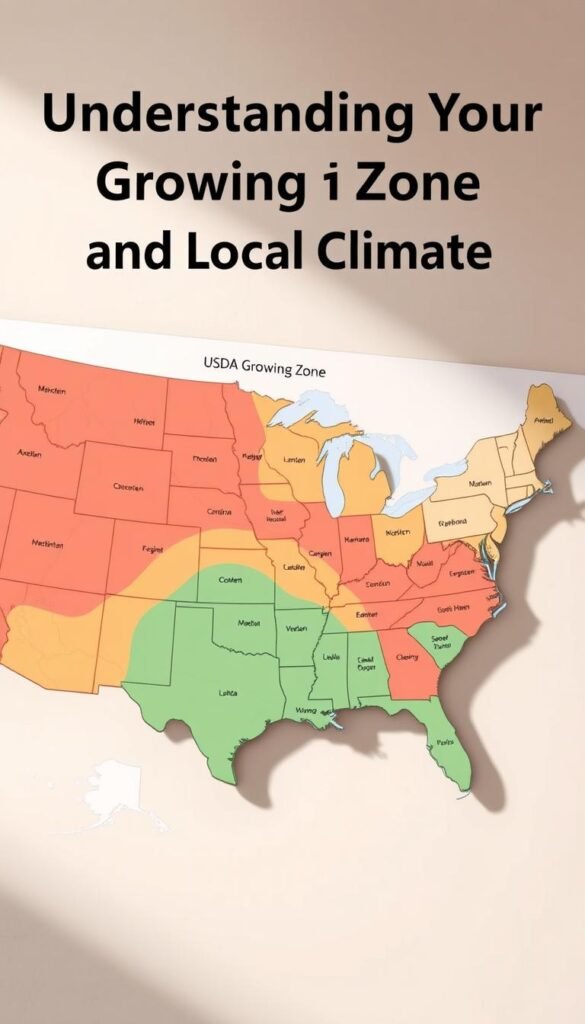
Your journey to a thriving landscape begins with understanding nature’s blueprint for your area. Plants have specific needs, and matching them to your region’s conditions ensures they’ll flourish through every season.
Identifying Your USDA Zone
The USDA Plant Hardiness Zone Map divides North America into 13 zones based on average winter lows. Enter your ZIP code on the USDA website to find your zone instantly. This number acts like a cheat sheet for choosing plants that can survive your coldest months.
For example, hydrangeas love zones 5-9 but struggle in extreme heat. Knowing your zone helps you avoid wasting time and money on varieties that won’t thrive. Local nurseries often label plants with zone info—look for tags saying “best for zones 7-10” or similar.
Assessing Weather and Microclimates
Your yard might have pockets warmer or cooler than your official zone. South-facing walls absorb heat, creating mini oases for tender plants. Low spots collect cold air, making them risky for early bloomers.
Track these factors to maximize success:
- Sun exposure patterns throughout the day
- Wind tunnels near fences or buildings
- Soil drainage in rainy seasons
Coastal areas face salt spray, while mountain regions deal with rapid temperature swings. Chat with neighbors or visit nearby parks to see which plants thrive naturally in your microclimate.
Evaluating Garden Conditions and Landscape Features

Your outdoor space holds unique secrets that determine which plants will thrive. Start by observing how sunlight dances across your yard and how water behaves after a storm. These clues shape your living canvas more than any catalog ever could.
Analyzing Sunlight and Soil Types
Track light patterns using free apps like Sun Seeker or old-fashioned stakes marked hourly. Full-sun areas (6+ hours daily) suit lavender and coneflowers, while hostas light up shady corners. Remember: winter sun sits lower, casting longer shadows over your space.
“Testing your soil is like reading its diary—it tells you exactly what your plants need to flourish.”
| Soil Type | Drainage Speed | Best Plant Matches |
|---|---|---|
| Sandy | Fast | Sedum, Russian Sage |
| Loamy | Moderate | Daylilies, Peonies |
| Clay | Slow | Irises, Swamp Milkweed |
Slopes and low spots affect water flow. Dig a 12″ hole and fill it—if water remains after 4 hours, consider raised beds. Existing trees create natural focal points but compete for nutrients. Work with these features rather than fighting them.
Notice how wind swirls around fences? Use dense shrubs as natural buffers. By embracing your landscape’s quirks, you create a design that feels effortlessly cohesive. Your reward? A garden that looks intentional in every season.
Seasonal Garden Design Tips: Planning for Year-Round Blooms

Transform your windows into living picture frames with the inside-out design strategy. Arrange taller specimens like ornamental grasses at the back of beds and low-growing violas near edges to craft scenes that delight from both indoors and outdoors.
Start by sketching sightlines from your favorite indoor viewpoints. Place winter-interest plants like red-twig dogwood where snow highlights their stems. In summer, let hydrangeas take center stage in those same sight corridors.
“A layered approach ensures no bare spots—think of it as nature’s relay race where one plant hands off beauty to the next.”
| Layer Height | Role | Seasonal Example |
|---|---|---|
| Tall (4-6 ft) | Backdrop/Structure | Autumn Joy Sedum (Fall) |
| Medium (2-3 ft) | Color Anchors | Salvia (Summer) |
| Low (6-12″) | Edging/Detail | Crocus (Spring) |
Balance is key: aim for 40% evergreens like boxwood to maintain shape. Fill the rest with staggered bloomers—peonies for spring, coneflowers for summer, and chrysanthemums for autumn frosts.
Map bloom cycles using a color-coded calendar. When tulips fade, daylilies should already show buds. This seamless flow keeps your space vibrant throughout the year, proving smart planning beats constant replanting.
Selecting a Diverse Mix of Plants for Continuous Color
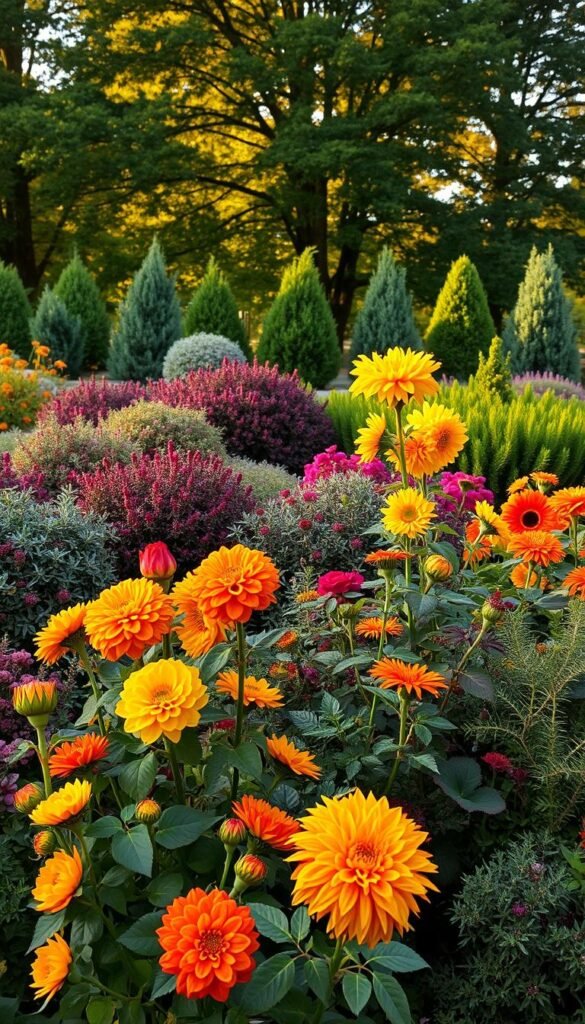
Crafting a lively outdoor space requires more than just pretty petals—it demands strategic plant partnerships. By blending perennials, annuals, and bulbs, you create a living tapestry that evolves with the seasons while keeping maintenance manageable.
Building Your Foundation With Reliable Performers
Perennials form your garden’s backbone, returning yearly with minimal fuss. Peonies and daylilies offer bold summer displays, while sedum thrives in autumn. For early spring surprises, plant bulbs like daffodils that multiply over time.
Annuals like zinnias or petunias fill gaps with instant color. Use them in colorful container displays or empty beds. They’re perfect for testing new hues without long-term commitments.
Elevating Your Space With Vertical Flair
Flowering shrubs and vines add structure and height. Hydrangeas anchor corners with summer-to-fall blooms, while clematis climbs trellises with star-shaped flowers. Consider these dynamic duos:
- Roses paired with jasmine vines for fragrance
- Elderberry shrubs beside morning glory screens
- Lavender hedges under climbing honeysuckle
| Plant Type | Bloom Season | Key Role |
|---|---|---|
| Peony | Late Spring | Focal Point |
| Crocus | Fall/Spring | Early/Late Color |
| Clematis | Summer | Vertical Interest |
Mix herbs like chives or thyme among your flowers. Their subtle blooms attract pollinators while spicing up your kitchen creations. This layered approach ensures something always catches the eye—whether it’s June’s roses or October’s golden foliage.
Structuring Your Garden with Evergreens and Hardscapes
A stunning outdoor space shines brightest when its bones stay strong through every season. Evergreens and hardscapes form the silent heroes of your landscape, working behind the scenes to maintain visual interest even when flowers take a winter nap.
Using Evergreens for Year-Round Structure
Think of evergreens as nature’s scaffolding. Upright varieties like ‘Sky Pencil’ holly draw the eye upward, while mounding shrubs such as boxwood create soft borders. These living pillars prevent your space from looking bare once autumn leaves fall.
Mix textures for depth: feathery junipers contrast beautifully with glossy magnolia leaves. Strategic placement matters most. Frame entryways with conical arborvitae or use cedar hedges to block chilly winds. Wildlife loves these shelters too—birds often nest in dense spruce branches.
| Evergreen Type | Height | Best Use |
|---|---|---|
| ‘Hudsonia’ Fir | 3-4 ft | Natural Foundation |
| Blue Star Juniper | 2 ft | Ground Cover |
| Italian Cypress | 15-20 ft | Vertical Accent |
Hardscapes bring balance to your design. A stone path winding through beds adds shape, while a rustic bench becomes a focal point during frosty mornings. Materials like weathered wood or wrought iron age gracefully, blending with plants as seasons change.
“Structure isn’t just about plants—it’s the dance between what grows and what endures.”
Keep proportions in check: aim for 60% greenery and 40% hard elements. This ratio ensures your space feels alive yet organized. With this framework, spring blooms and autumn colors will always have a polished stage to shine.
Planning Seasonal Highlights and Creative Transitions
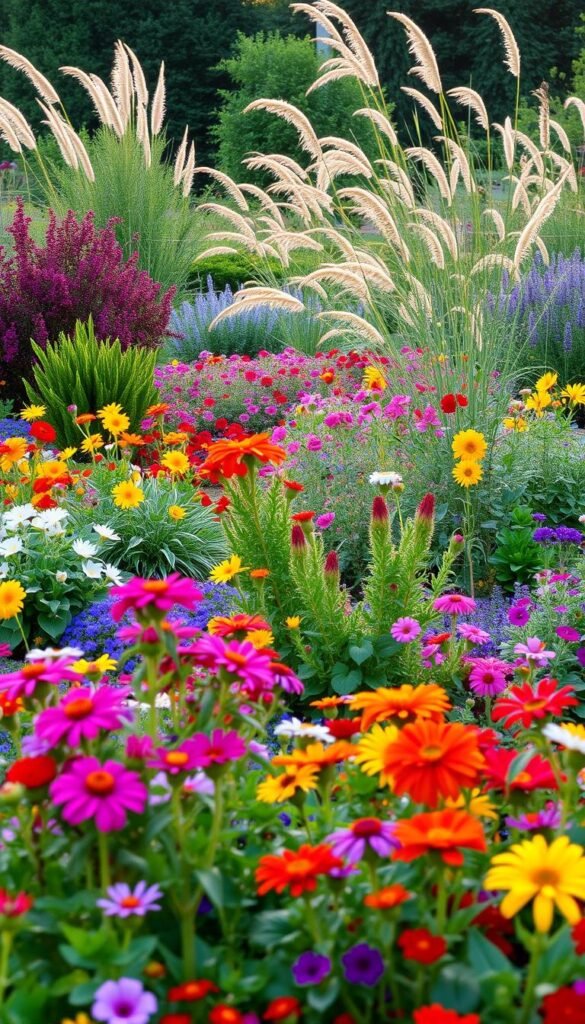
Nature’s rhythm offers endless opportunities for color when you plan with intention. By orchestrating your plant selections like a conductor leading an orchestra, you’ll create visual harmony that shifts gracefully between seasons.
Maximizing Bloom Periods with Succession Planting
Think of your outdoor space as a stage where performers take turns shining. Start with cold-hardy pansies in early spring, then transition to sun-loving zinnias as temperatures rise. When autumn arrives, let chrysanthemums steal the show.
Try this three-step approach:
- Plant quick-growing cosmos behind fading tulips
- Replace spent petunias with fall-blooming asters
- Interplant daffodils with late-emerging hostas
“A well-timed garden is like a fireworks display—each burst of color arrives precisely when the previous one fades.”
| Season | Early Performers | Late Stars |
|---|---|---|
| Spring | Crocus | Peony |
| Summer | Daylily | Phlox |
| Fall | Goldenrod | Sedum |
Protecting Blooms During Harsh Conditions
Sudden frosts or heat waves don’t have to ruin your display. Spread lightweight row covers over tender buds when frost threatens—they let light through while trapping warmth. During summer droughts, mulch acts like a sponge, keeping roots hydrated.
Smart strategies for tough winter months:
- Wrap shrubs in burlap screens
- Move potted geraniums indoors
- Apply compost tea to strengthen plants
With these techniques, you’ll extend bloom times and maintain vibrant colors even when weather throws curveballs. Your space becomes a living calendar, marking time through petals rather than pages.
Integrating Modern Design Elements and Visual Interest
Your outdoor area becomes a masterpiece when you blend artistic vision with nature’s patterns. Think beyond blooms—textured bark, sculptural evergreens, and strategic color pairings turn ordinary spaces into immersive experiences.
Crafting Depth Through Contrast
Play with opposites to create visual interest. Pair feathery grasses against glossy magnolia leaves or place spiky yucca beside soft lamb’s ear. These contrasts add energy even when flowers aren’t blooming.
Color coordination works like a painter’s palette. Start with spring’s lavender crocuses, transition to golden coreopsis in summer, then let fiery red maples dominate autumn. Paperbark maple adds texture year-round with its peeling cinnamon bark.
Layering plants by height guides the eye naturally. Tall ornamental grasses frame the back, mid-sized hydrangeas fill the middle, and creeping thyme spills over edges. This approach builds beauty that feels intentional yet effortless.
Don’t overlook foliage’s role. Japanese maples offer delicate leaves that shift from green to crimson, while hostas provide bold shapes. For creative solutions, explore unique decor ideas that mix function with artistry.
By balancing color, form, and texture, your space transforms into a living gallery. Each season reveals new details, proving great design isn’t just planted—it’s thoughtfully composed.
